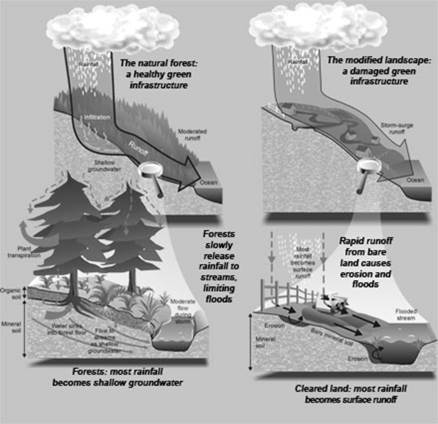|
Ecosystem Services for Disaster Risk Reduction
E Formally India’s capacity building interventions on linking climate change adaptation with disaster management started in 2007 with National Institute of Disaster Management’s pilot training module which was linked to the United Nations Development Programme’s Climate Resilient Development and Adaptation project. We called it a 2nd paradigm shift in Disaster Risk Management. Another module on ‘Environment and Disasters’ was launched in 2009. The Government of Uttar Pradesh sponsored a study by National Environmental Engineering Research Institute of the hilly districts of Uttarakhand and the risk of disasters was discussed therein while envisaging the roles ecosystems can play in ensuring sustainable human development. Another study on the green-house effect emphasized the role of natural vegetation strands in regulating micro and local climate vis-à-vis erosion and siltation. However, these lessons have not been taken into consideration while devising the model of economic development in the Himalayas. The interventions of German Development Organisation through the Indo-German Environment Programme with MoEF in India (Environmental Knowledge for Disaster Risk Management 2010-13) and its theme on Natural Resource Management - Disaster Risk Management linkage resulted in the development of a pilot ‘climate resilient disaster management’ project at the district and village level in Tamil Nadu and Andhra Pradesh while an ecosystem based adaptation has been envisaged in the Kosi Basin Programme of International Centre for Integrated Mountain Development. A documentation of the tsunami recovery programme that lays much stress on ecosystem based interventions like ‘Mangroves For the Future’ are clear lessons to be taken into account in our deliberations on disaster risk reduction process in ecologically sensitive areas. Wetlands play an important role in water retention, purification and re-charge, and -even more importantly- in flood control. Destruction of whole ecosystems, catchments, watersheds, wetlands, and change of land-use regimes in the name of development has caused instability, heavy siltation and landslides. Our failure to understand the linkages between the impacts of earthquake, forest fire, land-slides, water scarcity and floods contributed to building collapses in the Uttarakhand disaster. These challenges are not confined only to the Himalayas but are present in several other areas of the country where environmental devastations occur with an aggravated frequency and intensity. q Dr. Anil Kumar Sreeja S Nair
|
